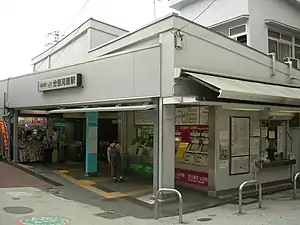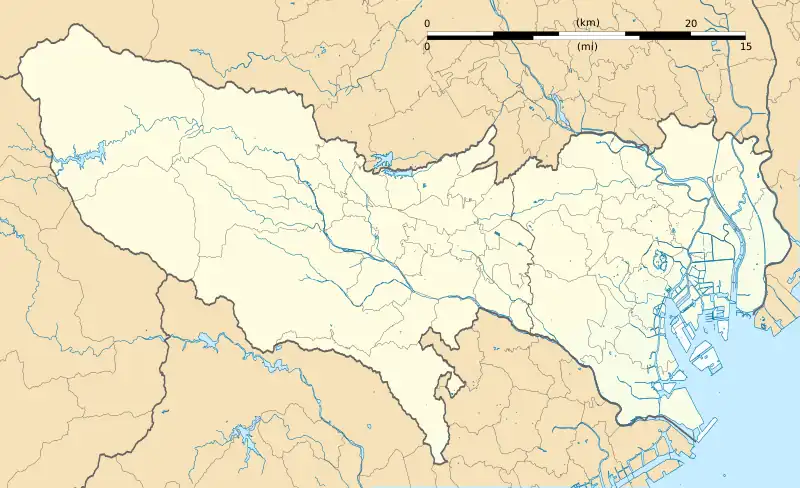Bubaigawara Station
Bubaigawara Station (分倍河原駅, Bubaigawara-eki) is an interchange passenger railway station located in the city of Fuchū, Tokyo, Japan, operated jointly by the East Japan Railway Company (JR East) and the private railway operator Keio Corporation.
JN21 Bubaigawara Station 分倍河原駅 | ||||||||||||||||||||||||||||||||||||
|---|---|---|---|---|---|---|---|---|---|---|---|---|---|---|---|---|---|---|---|---|---|---|---|---|---|---|---|---|---|---|---|---|---|---|---|---|
 Bubaigawara Station, June 2008 | ||||||||||||||||||||||||||||||||||||
| General information | ||||||||||||||||||||||||||||||||||||
| Location | 2-21-18 Katamachi, Fuchū-shi, Tokyo 183–0021 Japan | |||||||||||||||||||||||||||||||||||
| Coordinates | 35.6684°N 139.4686°E | |||||||||||||||||||||||||||||||||||
| Operated by | ||||||||||||||||||||||||||||||||||||
| Line(s) |
| |||||||||||||||||||||||||||||||||||
| Distance | 28.8 km from Kawasaki | |||||||||||||||||||||||||||||||||||
| Platforms | 4 side platforms | |||||||||||||||||||||||||||||||||||
| Other information | ||||||||||||||||||||||||||||||||||||
| Station code | JN21 (Nambu Line) KO25 (Keio Line) | |||||||||||||||||||||||||||||||||||
| Website | Official website | |||||||||||||||||||||||||||||||||||
| History | ||||||||||||||||||||||||||||||||||||
| Opened | 24 March 1925 | |||||||||||||||||||||||||||||||||||
| Passengers | ||||||||||||||||||||||||||||||||||||
| FY2019 | 41,240 (JR East) daily 95,121 (Keio) | |||||||||||||||||||||||||||||||||||
| Services | ||||||||||||||||||||||||||||||||||||
| ||||||||||||||||||||||||||||||||||||
| Location | ||||||||||||||||||||||||||||||||||||
 Bubaigawara Station Location within Tokyo  Bubaigawara Station Bubaigawara Station (Japan) | ||||||||||||||||||||||||||||||||||||
Lines
Bubaigawara Station is served by the Nambu Line, and is 28.8 kilometers from the Nambu Line terminus at Kawasaki Station. It is also served by the Keiō Line, and is 23.1 km from the Keio Line Tokyo terminus at Shinjuku.[1]
Station layout
The JR East and Keio Stations each have two side platforms serving two tracks. The two parts of the station share a common station building and entrance, with both JR and Keio ticket vending machines located side by side.
JR East platforms
The JR East platforms are located at ground level, running west to east.
| 1 | JN Nambu Line | for Fuchū-Hommachi, Noborito, and Kawasaki |
| 2 | JN Nambu Line | for Yaho and Tachikawa |
 The Nambu Line platforms viewed from a level crossing to the east of the station, January 2014
The Nambu Line platforms viewed from a level crossing to the east of the station, January 2014 The Nambu Line platforms looking east from platform 2, March 2013
The Nambu Line platforms looking east from platform 2, March 2013 The Nambu Lines looking west from platform 2, April 2008
The Nambu Lines looking west from platform 2, April 2008
Keio platforms
The Keio platforms are elevated and run approximately north to south.
| 1 | KO Keiō Line | for Keiō-Hachiōji KO Keiō Dōbutsuen Line for Tama-Dōbutsukōen (via Takahatafudō) KO Keiō Takao Line for Takaosanguchi (via Kitano) |
| 2 | KO Keiō Line | for Chōfu, Meidaimae, Sasazuka, and Shinjuku S Toei Shinjuku Line |
 The Keio Line platforms, December 2011
The Keio Line platforms, December 2011
History
The Keio Line station opened on 24 March 1925.[1] as Yashikibun Station (屋敷分駅). It was renamed to its present name on 11 December 1928. The JNR (now JR East) station also opened on 11 December 1928.[2]
Passenger statistics
In fiscal 2019, the JR station was used by an average of 41,240 passengers daily (boarding passengers only).[3] During the same period, the Keio station was used by an average of 95,121 passengers daily.[4]
The passenger figures (boarding passengers only) for previous years are as shown below.
| Fiscal year | Keio Daily average | JR daily average |
|---|---|---|
| 2005 | 75,792 | 35,970[5] |
| 2010 | 84,516 | 37,739[6] |
| 2015 | 90,754 | 40,036[7] |
Surrounding area
- MINANO (shopping center)
- Toshiba Fuchu Office
- Toshiba Digital Solutions
- Fuchu Katamachi Post Office
See also
References
- Terada, Hirokazu (July 2002). データブック日本の私鉄 [Databook: Japan's Private Railways]. Japan: Neko Publishing. p. 205. ISBN 4-87366-874-3.
- 各駅情報(分倍河原駅) [Station Information (Bubaigawara Station)] (in Japanese). Japan: East Japan Railway Company. Retrieved 15 February 2012.
- 各駅の乗車人員 (2020年度) [Station passenger figures (Fiscal 2019)] (in Japanese). Japan: East Japan Railway Company. Retrieved 29 January 2021.
- 1日の駅別乗降人員 [Station passenger figures (Fiscal 2019)] (in Japanese). Japan: Keio Railway Company. Retrieved 29 January 2021.
- 東京都統計年鑑 平成17年 9 運輸及び通信 [Tokyo Metropolitan Government statistics (fiscal 2005)] (in Japanese). Japan: Tokyo Metropolitan Government. Retrieved 26 March 2021.
- 東京都統計年鑑 平成22年 [Tokyo Metropolitan Government statistics (fiscal 2010)] (in Japanese). Japan: Tokyo Metropolitan Government. Retrieved 26 March 2021.
- 東京都統計年鑑 平成27年 9 運輸及び通信 [Tokyo Metropolitan Government statistics (fiscal 2010)] (in Japanese). Japan: Tokyo Metropolitan Government. Retrieved 26 March 2021.
External links
- JR East station information (in Japanese)
- Keio station information (in Japanese)